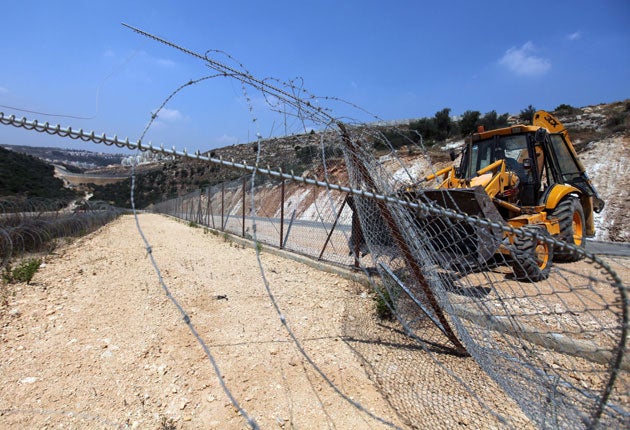Israel tears down part of West Bank barrier

Your support helps us to tell the story
From reproductive rights to climate change to Big Tech, The Independent is on the ground when the story is developing. Whether it's investigating the financials of Elon Musk's pro-Trump PAC or producing our latest documentary, 'The A Word', which shines a light on the American women fighting for reproductive rights, we know how important it is to parse out the facts from the messaging.
At such a critical moment in US history, we need reporters on the ground. Your donation allows us to keep sending journalists to speak to both sides of the story.
The Independent is trusted by Americans across the entire political spectrum. And unlike many other quality news outlets, we choose not to lock Americans out of our reporting and analysis with paywalls. We believe quality journalism should be available to everyone, paid for by those who can afford it.
Your support makes all the difference.Israel yesterday tore down a section of its contentious West Bank separation barrier, near a village that has come to symbolise Palestinian opposition to the enclosure.
The rerouting marked a major victory for the residents of Bilin and the international groups that have backed their struggle. But they said it fell short of their demands to remove the structure from the village altogether and vowed to continue their weekly protests.
The dismantling of the section near Bilin comes four years after Israel's Supreme Court ordered it torn down, rejecting the army's argument that the route was necessary to secure the nearby Modiin Illit settlement. Planning and legal wrangling held up its removal until now.
Colonel Saar Tzur, the regional brigade commander, said the army has begun taking apart a two mile stretch of the barrier and has replaced it with a 1.6 mile-long wall adjacent to the settlement. He said the new route would give the army less response time in case of a potential infiltration.
"This is a new threat but we can handle it," he said, adding that the work would be done by the end of the week.
Bilin lost half its land to the barrier, and years of weekly protests there have frequently evolved into clashes between activists and Israeli troops.
Israel began building the barrier in late 2002 to keep out Palestinian attackers amid a wave of suicide bombers targeting its cities. It says the structure is needed to keep militants from reaching Israeli population centres.
But the barrier juts into the West Bank, and critics say the route is designed to grab land that Palestinians want for a state. The barrier, when completed, is projected to swallow some 6 per cent to 8 per cent of the West Bank.
Tzur said the new route will put some 140 acres back in Palestinian hands.
The Bilin protests have become a ritual of sorts each Friday, making the once out-of-the-way farming village a fashionable cause among activists. Nobel Peace Prize laureates Jimmy Carter and Desmond Tutu are among the notables who have participated. Nearby Naalin started similar marches three years ago.
Two Palestinians, and five in Naalin have died and hundreds others have been wounded since the protests began in 2005.
One Bilin demonstrator was hit in the chest with a tear gas canister and another woman died after she inhaled tear gas. Palestinians said she had a pre-existing medical condition that was exacerbated by the acrid fumes.
Dozens of Israeli troops and police have been injured, including one who lost an eye.
Meanwhile, the Israeli government warned journalists on a humanitarian flotilla leaving for Gaza that they would face a 10-year ban from Israel.
Subscribe to Independent Premium to bookmark this article
Want to bookmark your favourite articles and stories to read or reference later? Start your Independent Premium subscription today.
Join our commenting forum
Join thought-provoking conversations, follow other Independent readers and see their replies
Comments